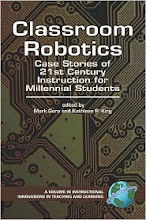INTERVIEW | by Victor Rivero
First there was humankind, now there’s RoboKind. When you hear it from Fred Margolin, CEO and co-founder of RoboKind, an advanced social robotics company, you begin to understand the power of what’s possible with robots, and why some of the nation’s top experts in robotics, artificial intelligence and electrical, mechanical and software engineering are all working so passionately. They are behind the technology that produces
When you put everything together, you have a tool that is completely attuned to special education.
the amazing RoboKind facial expressions for what they believe are the most lifelike robots in the world. The robots also have humanoid bodies, and even what Fred describes as “CompuCompassion” — which he talks about in more depth in this interview. For education, the implications aren’t just fascinating. Autistic and special needs children are already benefitting with immediate results. How did Fred get involved in this line of work? “My son worked closely as an engineer with David Hanson, whose company, Hanson Robotics, pioneered the development of robots with human-like faces,” he explains. “I recognized the huge potential of these robots, but also that they needed to be scaled down in price and size before entering the consumer market.” Fred bought the patent, and as a result, his company is able to offer the most affordable humanoid robots available today. Fred is a graduate of Harvard Business School where he obtained his MBA, and he earned his B.A. at The Wharton School of Business and The University of Pennsylvania. In this discussion, he addresses what his company has developed, what happens when these tools are used in special education, and he goes into much more depth about the very human approach behind Robots4Autism.Victor: What drives the development process of social robotics and the Robots4Autism program at RoboKind?
Fred: RoboKind has a vision of how social robots can best serve the special education, autism therapy and STEM instruction markets; a vision which drives everything we develop. Our goal is to create a long-term platform for communication, information and entertainment.
With regard to Robots4Autism, we developed each aspect of the robot to leverage the fascination with technology that engages many individuals with autism. Our development strategy, however, also encompasses the principle of attainability, so that these robots remain affordable for schools and therapy centers. Finally, we’ve gathered user feedback from autism treatment experts at the Callier Center for Communication Disorders at the University of Texas at Dallas. With their guidance, the robot became part of a team effort, expanding the role of teachers and therapists in an efficient and effective manner.
Victor: What are the benefits of incorporating social robots into autism intervention and education?
Fred: There are three major benefits. First, the robot offers a non-threatening platform to deliver the behavioral curriculum. With life-like facial expressions, the robot teaches emotions and social skills, and the child is not intimidated, as he or she might be with human interactions. In fact, one therapist reported that two children who previously refused to speak with staff began speaking to the robot within 10 minutes of interaction.
Another benefit is the ability of our CompuCompassion software to read the child’s emotions and level of attentiveness, and use this information to adjust its interaction. If the software senses distraction or disengagement, it redirects the child’s attention, promoting a more consistent degree of engagement.
The third benefit of social robots is they never get bored, allowing for higher doses of interaction. While human teachers and therapists might tire of reiterations, Robots4Autism enables perfect repetition without any fluctuations in tone. Each phrase is pronounced again and again in the same manner, without a hint of frustration or impatience, until the child is ready to move onto the next task.
Read the full article at its source: http://edtechdigest.wordpress.com/2014/02/07/embracing-the-robot/



No comments:
Post a Comment